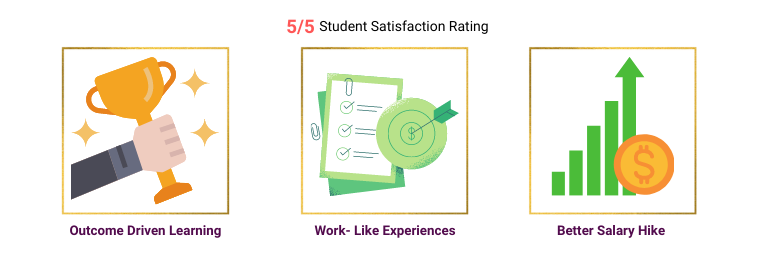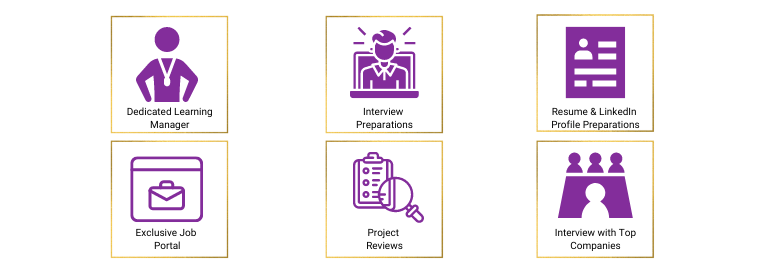SAC Analytics Cloud Planning, Reporting and Analytics Online Training
SAC Analytics for cloud is cloud SaaS based Business Intelligence tool provided by SAP company. It was formerly known as BusinessObjects for cloud. It provides all the key functionalities of an Analytics tool to SAP business users.
This tool is developed by SAP on HANA based BI platform and provides analytics compatibility from data coming from different database, CRM and ERP solutions. You can fetch data from Microsoft SQL, ERP solutions and Salesforce. Business users can compile the data, perform the data discovery, ad-hoc reporting and analysis to support predictive planning. SAP Analytics tool converts the raw data from transactional system into meaningful insight for making better decisions.
Analytics feature in SAP tool depends on data algorithms, programming, and operations research to get data insight and to help the business in finding meaningful information from data coming from multiple data sources. This information is used by all enterprises to perform the business planning and forecasting.
In collaboration with
Online Class
Projects
Hands-On
n/a

40 Hrs Instructor-led Training
Mock Interview Session
Project Work & Exercises
Flexible Schedule
24 x 7 Lifetime Support & Access
Career Guidance



Course Benefits




SAC Analytics Cloud Online Training Course Overview
SAC is a complete platform that helps you analyze, plan, and integrate many functions necessary to run a business. Being a trending technology, the demand for such professionals never goes low. The certification is the parameter that helps in examining your skills of handling SAC.
If you are aspiring to be one of the following, then this training is for you!
-
Business Users
-
Data Analysts
-
Application Developers
-
Financial Planning Consultants
-
Anyone who is interested in learning Analytics Cloud
There are no such prerequisites for this course; anybody who is keen to learn can opt for this
This course is a summary of each area of SAC with active exercises in most. the main focus is that the BI practicality and building and navigating in stories with a further specialize in Digital room. though these areas would be thought of the core of the category, the course addresses all the areas of SAC as well as designing, user management, and roles, yet as a sourcing and haggle knowledge with hands-on exercises in every one of those areas.
1. Understand the role of SAP Analytics Cloud in the over all SAP Cloud Portfolio
2. How to integrate data with SAP Data sources and Non – SAP Data Sources
3. Create Planning Data Dashboards in SAC
4. Simplifying Predictive with Smart Predict
5. How to define users, teams, roles, and security
6. Create presentations with SAP Analytics cloud digital boardroom
Talk to Us
IN: +91-8197658094
- This course is not affiliated with or endorsed by SAP.
- SAP is a trademark of SAP SE, and this course is not officially associated with SAP.
Fees
Online Classroom
- 40 Hrs of Instructor-led Training
- 1:1 Doubt Resolution Sessions
- Attend as many batches for Lifetime
- Flexible Schedule
Batches
Dates
Days
Timings
Enrolment validity: Lifetime
Login
EMI Option Available with different credit cards
Cart
Corporate Training
- Customised Learning
- Enterprise grade learning management system (LMS)
- 24x7 Support
- Enterprise grade reporting
Course Content
SAC Analytics Cloud Online Training Course Content
1.1 SAP Analytics Cloud Product Overview
1.2 SAP Analytics Cloud Positioning
1.3 SAP Analytics Cloud Architecture Overview
1.4 SAC vs other BI tools and its convergence to SAC
1.5 Benefits & core functionalities of SAC
1.6 Cloud vs On-Premise vs Hybrid
1.7 SAP Analytic Cloud Client tools and Importance
1.8 Data Discovery Roadmap Update
2.1 Overview of Connections
2.2 Data Source Overview
2.3 Data Integration Options
2.4 Semantics Enrichments
2.5 Live Connections
2.6 Import Connections
2.7 Connecting and accessing Flat file data
2.8 Connecting and accessing SAP-HANA *
2.9 SAP Analytics Cloud and SAP BW *
2.10 BW Structure support, Hierarchy handling,Merging of prompts, BW Variants and
Personalization support, Enhanced BW variable support, BW query default presentation,
Custom KPI *
2.11 ABAP CDS query integration*
2.12 Enrich S/4HANA with SAP Analytics Cloud*
2.13 Integration with SAP Fiori Launchpad *
2.14 SAC Analytics Content Accelerators *
2.15 Data import connectivity to SAP S/4HANA, BW *
3.1 What is MODEL
3.2 Components of MODEL
3.3 Data Preparation
3.4 Smart Data Wrangling
3.5 Working with Dimension and Classification
3.6 Configuring Geo-Dimension and working for Geo Spatial modeling
3.7 Working with Measures
3.8 Working with Transformations
3.9 Working with Variables
3.10 Working with Hierarchies
4.1 Designing SAC Stories
4.2 Working with Custom Templates
4.3 Working with Standard Templates
4.4 Working with Canvas-Responsive & Grid modes
4.5 Working with Designer(Builder panel , Styling Panel)
4.6 Filters in SAC
4.7 Query level filters
4.8 Story level filters
4.9 Page level filters
4.10 Widget level filters
4.11 Advanced Filters
4.12 Linked Analysis
4.13 Hyperlinking
4.14 Conditional Formatting
4.15 Customizing Measures
4.16 Customizing Dimensions
4.17 Data blending
4.18 Working with Chart widget
4.19 Working with Table widget
4.20 Working with Geo Map widget
4.21 Generating R based visualization
5.1 What is Augmented Analytics
5.2 Smart Search
5.3 Smart Discovery
5.4 Smart Insights
5.5 Search to Insights
5.6 Smart Predict
6.1 What is SAP Analytics Designer
6.2 Difference between SAC Stories vs SAP Analytics Designer
6.3 Analytics Designer overview and walkthrough
6.4 Outline, Designer, Error & reference panels
6.5 Design mode vs Run mode vs View mode
6.6 Designing basic Analytic application
6.7 Working with Container widgets
6.8 Implementing filters
6.9 working with Drop-down,Radio button,Checkbox components
6.10 working with script variables
6.11 working with script objects
6.12 Configuring and implementing Dynamic Visibility
7.1 Predictive scenario overview
7.2 SAC Stories vs SAC Applications vs SAC Predictive
7.3 Working with Datasets, Variables
7.4 Implementing Classification Predictive Model
7.5 Implementing Regression Predictive Model
7.6 Implementing Timeseries Predictive Model
7.7 Generating predictive stories
8.1 SAC Planning Overview
8.2 Roles required for Planning
8.3 Planning functions
8.4 Planning Allocation
8.5 Using Allocation: Spreading, Distribution, Assignment
8.6 Using Predictive forecast in planning
8.7 Understanding Allocation rules, Input task, Value Driver Tree( Overview )
8.8 Planning in S/4HANA( Embedded planning overview)
8.8 Planning Scenario BPC vs SAC
8.9 Hybrid Scenario for Planning
9.1 SAC Administration Overview
9.2 Roles(Standard vs Custom)
9.3 Team
9.4 Users
9.5 Working with data loading and scheduling
9.6 SAP Cloud connector
9.7 SAP Analytics Cloud Agent
9.8 SAC Lifecycle management/Transports
10.1 SAP SAP Analytics Cloud and SAP Analytics HUB Roadmaps
10.2 SAC Mobile
10.3 Industry Content
10.4 How to use industry content and 3rd party Content
10.4 Keep learning links
10.5 SAC Roadmaps(Current vs Future)
10.6 SAC Project Implementation landscapes
10.7 SAC Certification Overview
Course Projects
Develop a basic understanding on how to create visualizations within SAP Analytics Cloud.
Exercise Description: You want to get an understanding about what data is available to you and based on your finance data find your first insights about company’s performance over time. Key Features: • Interact with Explorer to create dynamic visualization and understand your data better • Copy and paste widgets from explorer to an existing dashboard • Understand how to use the Builder Panel • Create a variety of different charts to illustrate key relationships within your data
Develop a basic understanding on how to make a dashboard more dynamic for your viewers to draw insights between multiple visualizations.
Exercise Description: In the last section, we created our first story and added new visualizations. However, currently our dashboard is quite static. In this section, we want to add interactive capabilities to the dashboard by adding new filters and input controls. This way our dashboard can be easily used by a number of different employees at the company - each user will be able to easily manipulate the dashboard view and only see what is important to them. Key Features: • Learn about page filters and how to apply them to a subset of widgets only • Understand how to add a measure and dimension input control to dynamically change the context of your data visualization • Understand how to set up linked analysis to drive filters via widget interaction
Create a Geo Visualization with location data and use variances and thresholds to draw attention to what is important in your dashboard by highlighting where to focus on.
Exercise Description: In previous sections we added charts, tables and made the dashboard interactive with input controls and linked analysis. You now need to include geographical data as part of your analysis as well as ensuring other employees can quickly draw conclusions when looking at the dashboard you created. This can be achieved with thresholds and variances. Key Features: • Create Geo Visualization • Learn about Bubble and Choropleth layers and drill down a geographical hierarchy • Use recommended comparison to quickly add variances to a chart • Learn how to add a dynamic reference lines and sort a chart • Understand how to add a threshold to a table
Course Certification
Mentors Pool is ready to help with every possible effort. For any course material assistance (Mock Questions, Sample Questions or Study Material), get in touch with our representatives. We would be more than happy to help you!
Mentors Pool’s Trainers are experienced and trained professionals with more than five years of experience. They take care of SAC Analytics Cloud training need globally. They are ready to help with your query and clear every doubt with the interaction sessions and QnA(s)
We understand your confusion. No doubt, the IT world is full of technologies. Deciding on the pick of certification can be confusing. We recommend you to get in touch with our Trained and Experienced professionals. They can help and counsel you on the needs and benefits of various certifications.
we will provide all datasets to build stories of BI, planning, ML, and analytic designer.
Our training and certification program gives you a solid understanding of the key topics covered in the SAP Analytics Cloud Training. In addition to boosting your income potential, getting certified in SAP Analytics Cloud demonstrates your knowledge of the skills necessary to be a skilled SAP Consultant. The certification validates your ability to produce reliable, high-quality results with increased efficiency and consistency.
1. Analytics Cloud is one simple cloud solution for BI, Planning, and Predictive. It connects people, information, and ideas to enable fast and confident decision making.
2. With the power of machine learning and predictive analytics, Analytics Cloud integrates business intelligence and corporate planning to simplify organizational analytics for any industry.
3. Integration with Analysis for Microsoft Office: This includes a read and write a function for users who want to import data and work in readily familiar environments.
4. Access to on-premise and cloud data: Provides real-time access to applications such as cloud databases and solutions, as well as heterogeneous applications for on-premise and cloud locations.
5. Embedded analytics Allows users to access analytic features such as what-if analysis and ad-hoc.
6. Access to s4 solutions: This combines transactions, analytics, and planning in one application.
Certification Course Reviews
Certification Course FAQs
SAP Analytics Cloud is a single solution for business intelligence, augmented and predictive analytics, and enterprise planning with the power of artificial intelligence and machine learning technology. It is embedded in SAP’s cloud enterprise applications delivering analytics in the context of business processes and has unique, direct connectivity to SAP data sources, and provides data integration, management, and analysis capabilities on a common, enterprise-grade infrastructure in the cloud for all data (SAP and non-SAP).
There are a few reasons why SAP Analytics Cloud is different from other analytics solutions. For starters, SAP Analytics Cloud is 100% accessible in the cloud. This means you’ll only need your web browser to access your account, no desktop application setup is required.
Thanks to the SAP Business Technology Platform, SAP has unique, direct connectivity to SAP data sources and provides data integration, management, and analysis capabilities on a common, enterprise-grade infrastructure in the cloud for all data (SAP and non-SAP).
What makes SAP Analytics Cloud truly stand out from other solutions is our integrated planning capabilities. Bringing planning and business intelligence together allows you to analyze, report, budget, and forecast within a single solution. And, with SAP Digital Boardroom, you can extends SAP Analytics Cloud to provide a 360° view across all Lines of Business and operations to transform the modern boardroom experience on large touchscreen displays.
SAP Analytics Cloud also has augmented and predictive analytics features powered by artificial intelligence and machine learning technology.
As well, SAP Analytics Cloud offers a mobile app for iOS devices, so you can access your dashboards anywhere, anytime. You can download it for free from the app store.
There’s a reason we’re recognized for leading customer experience and analytics. SAP Analytics Cloud is designed to scale for businesses of any size, from a sole proprietorship to large enterprises. And for more details, check out our plans and options page.
Collaborating is super easy with SAP Analytics Cloud. You can easily export dashboards as PDF, PowerPoint, or Google Slides files. Scheduling publications also allows you to share a dashboard on a regular cadence to your stakeholders through email. With the calendar, you can create tasks, assign tasks to other users, and set due dates. You can also chat with your team, in real-time or through notifications!
SAP Analytics Cloud can connect to various on-premise and cloud data sources including SAP HANA, SAP BW, SAP BPC, OData, Google BigQuery, SQL, SAP Universes and more
Once you sign up for a free trial, you will have initial access to SAP Analytics Cloud for 30 days.






